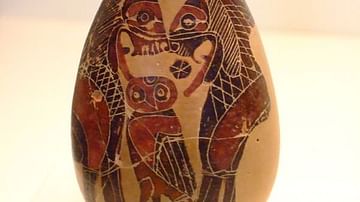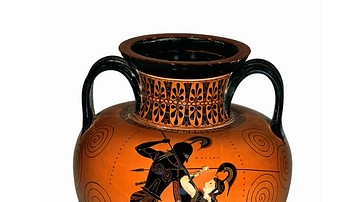
Red-figure Pottery is a style of Greek vase painting invented in Athens c. 530 BCE. The style has drawn red figures and a painted black background. Red-Figure Pottery grew in popularity, and by the early 5th century BCE it had all but replaced black-figure pottery as the predominant pottery type in Athens. The last recorded examples are from c. 320 BCE.
In red-figure pottery, the figures are created in the original red-orange of the clay. This allowed for greater detail than in black-figure pottery, for lines could be drawn onto the figures rather than scraped out. This made the painted scenes both more detailed and more realistic, and allowed red-figure painters the opportunity to work with greater perspective. In black-figure painting, figures were almost always shown in profile, but red-figure allowed for frontal, back and three-quarter views, therefore creating a third dimension to the painting.
Like black-figure pottery, red-figure pottery was created in a variety of shapes for specific uses. Daily use pottery, such as amphora for transporting goods and hydria for drawing water, often depicted scenes of daily life. Pots designed for ritual use, such as the lekythos for pouring libations, usually had scenes of religious importance.
Athens remained the lead producer in red-figure pottery, in both quality and quantity, but eventually the style spread to other Greek regions, especially Southern Italy. The subject matter of red-figure vases varied greatly, from portraits of gods and heroes to depictions of every day Athenian life. As such, these paintings provide an archaeological record of historical, social, and mythological information.
Academics have been able to identify individual artists and artistic groups as painters of these red-figure vessels. The most definitive work on the identification of these artists is Sir John Beazley's Attic Red-figure Vase-painters, first published in 1925. Beazley, a professor at Oxford University, catalogued over 65,000 vases and fragments, and identified over 17,000 artists.
Of these identified painters, the Andokides Painter is usually credited with the invention of the style. He was joined by several other early adopters of the technique, including the so-called “Pioneer Group” of Euphronios, Euthymides, and Phintias. These early red-figure painters were often “bilingual,” meaning that they worked in both red- and black-figure for a period of time. Notable painters emerged from the late Archiac period such as the Berlin Painter, the Kleophrades Painter, and Douris, as the technique became more refined and began to dominate in the Mediterranean world. Mastery of the technique continued in the Classical period with famous painters such as the Achilles Painter, the Providence Painter, and the Pan Painter. Later famous artists include the Eretria Painter, the Meidias Painter, who achieved new levels of detail in painting garments, and the Meleager Painter.





